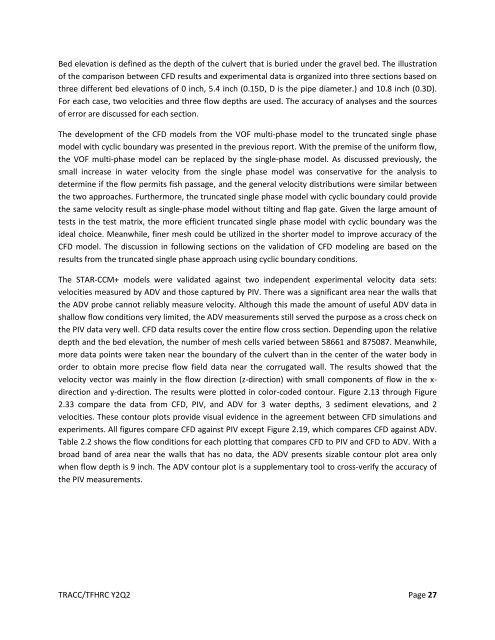Computational Mechanics Research and Support for Aerodynamics ...
Computational Mechanics Research and Support for Aerodynamics ...
Computational Mechanics Research and Support for Aerodynamics ...
- No tags were found...
You also want an ePaper? Increase the reach of your titles
YUMPU automatically turns print PDFs into web optimized ePapers that Google loves.
Bed elevation is defined as the depth of the culvert that is buried under the gravel bed. The illustration<br />
of the comparison between CFD results <strong>and</strong> experimental data is organized into three sections based on<br />
three different bed elevations of 0 inch, 5.4 inch (0.15D, D is the pipe diameter.) <strong>and</strong> 10.8 inch (0.3D).<br />
For each case, two velocities <strong>and</strong> three flow depths are used. The accuracy of analyses <strong>and</strong> the sources<br />
of error are discussed <strong>for</strong> each section.<br />
The development of the CFD models from the VOF multi-phase model to the truncated single phase<br />
model with cyclic boundary was presented in the previous report. With the premise of the uni<strong>for</strong>m flow,<br />
the VOF multi-phase model can be replaced by the single-phase model. As discussed previously, the<br />
small increase in water velocity from the single phase model was conservative <strong>for</strong> the analysis to<br />
determine if the flow permits fish passage, <strong>and</strong> the general velocity distributions were similar between<br />
the two approaches. Furthermore, the truncated single phase model with cyclic boundary could provide<br />
the same velocity result as single-phase model without tilting <strong>and</strong> flap gate. Given the large amount of<br />
tests in the test matrix, the more efficient truncated single phase model with cyclic boundary was the<br />
ideal choice. Meanwhile, finer mesh could be utilized in the shorter model to improve accuracy of the<br />
CFD model. The discussion in following sections on the validation of CFD modeling are based on the<br />
results from the truncated single phase approach using cyclic boundary conditions.<br />
The STAR-CCM+ models were validated against two independent experimental velocity data sets:<br />
velocities measured by ADV <strong>and</strong> those captured by PIV. There was a significant area near the walls that<br />
the ADV probe cannot reliably measure velocity. Although this made the amount of useful ADV data in<br />
shallow flow conditions very limited, the ADV measurements still served the purpose as a cross check on<br />
the PIV data very well. CFD data results cover the entire flow cross section. Depending upon the relative<br />
depth <strong>and</strong> the bed elevation, the number of mesh cells varied between 58661 <strong>and</strong> 875087. Meanwhile,<br />
more data points were taken near the boundary of the culvert than in the center of the water body in<br />
order to obtain more precise flow field data near the corrugated wall. The results showed that the<br />
velocity vector was mainly in the flow direction (z-direction) with small components of flow in the x-<br />
direction <strong>and</strong> y-direction. The results were plotted in color-coded contour. Figure 2.13 through Figure<br />
2.33 compare the data from CFD, PIV, <strong>and</strong> ADV <strong>for</strong> 3 water depths, 3 sediment elevations, <strong>and</strong> 2<br />
velocities. These contour plots provide visual evidence in the agreement between CFD simulations <strong>and</strong><br />
experiments. All figures compare CFD against PIV except Figure 2.19, which compares CFD against ADV.<br />
Table 2.2 shows the flow conditions <strong>for</strong> each plotting that compares CFD to PIV <strong>and</strong> CFD to ADV. With a<br />
broad b<strong>and</strong> of area near the walls that has no data, the ADV presents sizable contour plot area only<br />
when flow depth is 9 inch. The ADV contour plot is a supplementary tool to cross-verify the accuracy of<br />
the PIV measurements.<br />
TRACC/TFHRC Y2Q2 Page 27

















